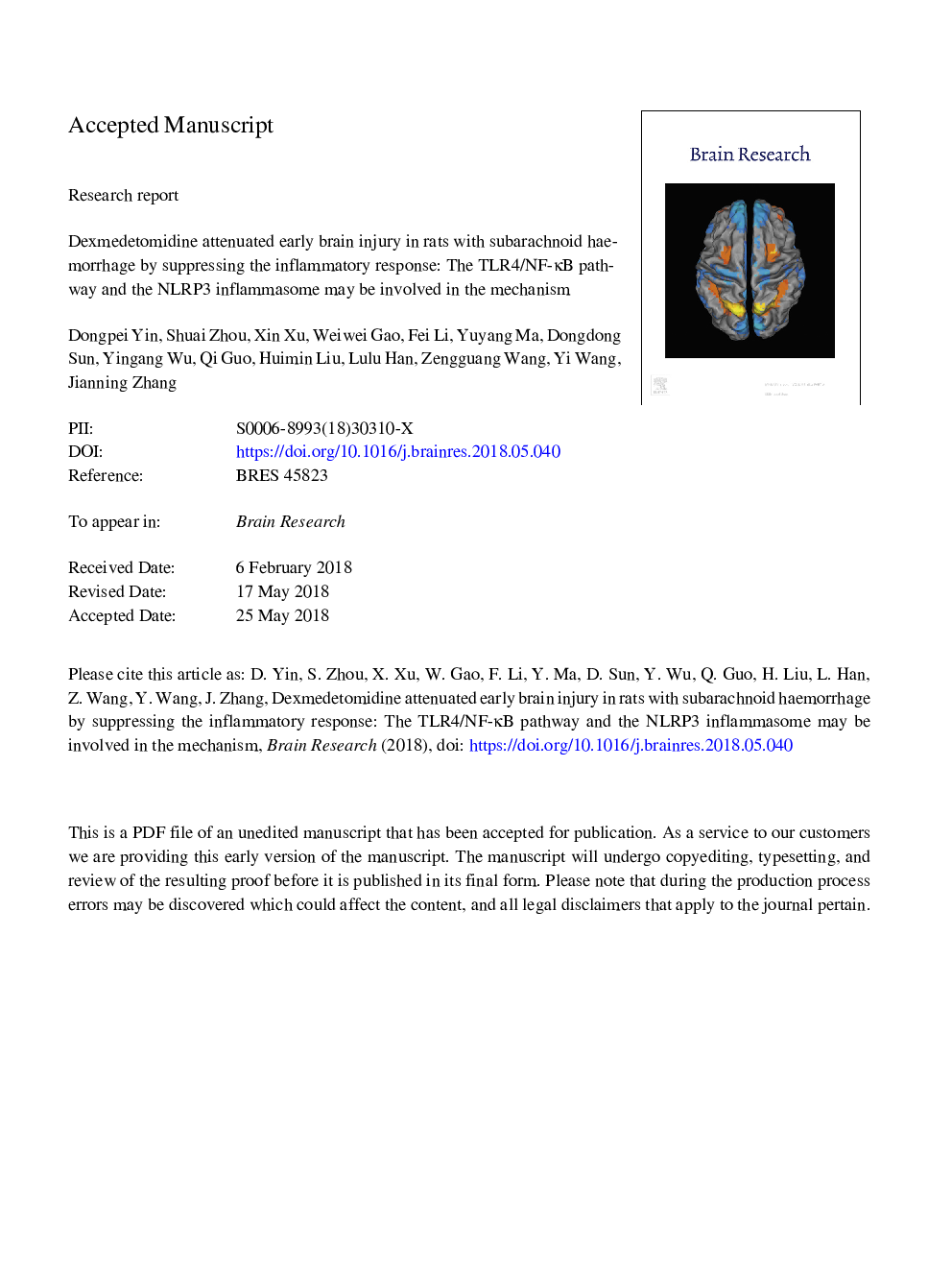| کد مقاله | کد نشریه | سال انتشار | مقاله انگلیسی | نسخه تمام متن |
|---|---|---|---|---|
| 8839651 | 1613746 | 2018 | 35 صفحه PDF | دانلود رایگان |
عنوان انگلیسی مقاله ISI
Dexmedetomidine attenuated early brain injury in rats with subarachnoid haemorrhage by suppressing the inflammatory response: The TLR4/NF-κB pathway and the NLRP3 inflammasome may be involved in the mechanism
دانلود مقاله + سفارش ترجمه
دانلود مقاله ISI انگلیسی
رایگان برای ایرانیان
کلمات کلیدی
IL-18EBIIL-6MCAODEXDAMPsIL-1βICAECAMCP-1ASCCCABSA - BSAEarly brain injury - آسیب مغزی زودرسbovine serum albumin - آلبومین سرم گاوdamage-associated molecular patterns - الگوهای مولکولی مرتبط با آسیبmiddle cerebral artery occlusion - انسداد شریان (سرخرگ) مغزی میانیCerebral ischaemia - ایسکمی مغزیInterleukin-18 - اینترلوکین ۱۸interleukin-6 - اینترلوکین ۶Interleukin-1 beta - اینترلوکین-1 بتاEvans Blue - ایوانز آبیEnzyme-linked immunosorbent assay - تست الیزاELISA - تست الیزاCNS - دستگاه عصبی مرکزیDexmedetomidine - دگزامتامینیدینBBB - سد خونی مغزیcentral nervous system - سیستم عصبی مرکزیexternal carotid artery - شریان کاروتید خارجیinternal carotid artery - شریان کاروتید داخلیcommon carotid artery - شریان کاروتید مشترکbloodbrain barrier - مانع خونریزی مغزیapoptosis-associated speck-like protein containing a caspase recruitment domain - وابسته به پروپول های وابسته به آپوپتوز، حاوی دامنه استخدام کاسپاز
موضوعات مرتبط
علوم زیستی و بیوفناوری
علم عصب شناسی
علوم اعصاب (عمومی)
پیش نمایش صفحه اول مقاله

چکیده انگلیسی
Early brain injury (EBI) plays a pivotal role in the prognosis of patients with subarachnoid haemorrhage (SAH). Dexmedetomidine (DEX), a highly selective α2 receptor agonist, is reported to exert multiple protective effects in many neurological diseases. This study was designed to investigate whether DEX had neuroprotective functions in EBI after SAH, and to explore the possible mechanisms. The SAH model was established by an endovascular perforation in adult male Sprague-Dawley (SD) rats. DEX (25â¯Âµg/kg) or vehicle was administered intraperitoneally 2â¯h after SAH. Neurological deficits, brain oedema, inflammation, BBB damage, and cell apoptosis at 24â¯h after SAH were evaluated. Additionally, the expression of components of the Toll-like receptor 4 (TLR4)/nuclear factor-κB (NF-κB) pathway, and the nucleotide-binding oligomerization domain-like receptor family pyrin domain-containing 3 (NLRP3) inflammasome were also assessed. We demonstrated that DEX treatment improved neurological scores, alleviated brain oedema, reduced the permeability of the blood-brain barrier (BBB), and up-regulated the expression of tight junction proteins. DEX treatment could reduce the neutrophil infiltration, microglial activation, and pro-inflammatory factor release. In addition, DEX alleviated cell apoptosis at 24â¯h after SAH. Notably, DEX could also suppress the activation of the TLR4/NF-κB pathway and the NLRP3 inflammasome. These findings suggested that treatment with DEX after SAH attenuated SAH-induced EBI, partially through the suppression of the TLR4/NF-κB pathway and the NLRP3 inflammasome.
ناشر
Database: Elsevier - ScienceDirect (ساینس دایرکت)
Journal: Brain Research - Volume 1698, 1 November 2018, Pages 1-10
Journal: Brain Research - Volume 1698, 1 November 2018, Pages 1-10
نویسندگان
Dongpei Yin, Shuai Zhou, Xin Xu, Weiwei Gao, Fei Li, Yuyang Ma, Dongdong Sun, Yingang Wu, Qi Guo, Huimin Liu, Lulu Han, Zengguang Wang, Yi Wang, Jianning Zhang,